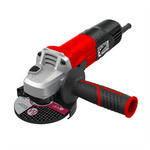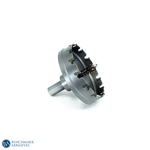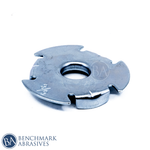
Types of Buffing Wheels You Should Be Aware of

Buffing wheels are finishing tools used to smooth a workpiece's surface. The buffing wheel provides smooth satin finishing on the metal surfaces. It is too easy to make smooth, finish, mix, or polish almost any surface with the help of buffing grinder wheels.
There are different types of buffing wheels, each built to fulfill specific tasks. Every buffing wheel and buffs are designed from three types of traditional centers for interacting with different machines. Such as,
- A leather stitched center provides stiffness and durability to any buff.
- Plastic center buff functions like the old conventional leading centers, providing longer durability without the risk of using the lead.
- Finally, an economical alternative is a shellac center that provides a tight fit on various tapered spindles.
Here, we have listed different types of buffing & polishing wheels and their characteristics. Choose the best ones for you and your job.
What is a Buffing Wheel?
Buffing wheels are an abrasive wheel that carries a polishing compound. Metal surfaces are made smoother and more polished by these substances. There are different types of buffing compounds. The buffing wheel rotates when the compound is applied to it. You need to continue applying the polishing compound to give the surface or jewelry smoothness and a high shine.
Different Types of Buffing Wheels

1. Cotton and Muslin Buffs
The soft cotton muslin buffs are made of cotton, commonly used for a final polish with buffing rouge. Muslin buffs, like chamois or cotton flannel buffs, are similar to other cotton buffs and are much more effective. These cotton pads are a perfect buffing wheel for a drill. They come in two forms: combed and uncombed.
-
Uncombed – The surface of uncombed muslin buffs is harder than that of combed muslin buffs. These are perfect for rough finishing and removing marks on the workpieces if they are used with an abrasive compound.
-
Combed – The combed cotton muslin buff is used for the final finishing touch with a high polish for workpieces with polishing compounds. The stitching gives stiffness to the buff, allowing more pressure to be exerted against it.
2. Felt Buffs
Felt buffs are made of wool fabric; It is thick and strongly compressed. For any polishing or buffing procedure, the felt buff wheels' medium hardness is perfect. These buffs are suitable with any buffing compound for cutting or polishing. They are the perfect buffing wheel for angle grinders working in angles and corners, available in varying densities from mild to extra rough. The pinhole core of most felt buffs allows you to use them on tapered spindles.
3. Satin/Matte Buffs
A satin and Matte finish buff is made from synthetic or nylon fibers attached with an abrasive buffing wheel material such as silicon carbide or aluminum oxide. Matte buffs are ideal for getting a beautiful polished look on watch bands and other workpieces. It is a perfect finishing tool for any workpiece, especially for wood, plastic, and other materials.
4. Aluminum Oxide Flap Wheels
These flap wheels are integrated with the aluminum oxide abrasive granule that gives effective polishing. Flap wheels are flexible wheels to use on watch bands or non-ferrous metals for light deburring and polishing jobs. They can also be used on steel to produce a satin finish and to remove surface particles from the metal easily.
5. Silicon Carbide Wheels
The silicon carbide wheel is a much stronger and tougher grinding wheel than other polishing wheels. These silicon carbide wheels are ideal for light grinding, deburring, smoothing, and cleaning of all non-ferrous metals, as well as non-metallic materials such as glass.
6. Nylon and Wire Wheels and Brushes
The nylon wire wheels are polishing buffing wheels that are perfect for brushing, deburring, and smoothing rough surfaces. These buffing wheels are easy to mount and unmount with mandrels. Other than nylon, these buffing wheels and brushes are also composed of brass and steel bristles. Brass wire brushes are specific for gold, copper, and brass workpieces. In contrast, steel wire brushes are best for white metals such as silver, white gold, platinum, and aluminum.
How To Select The Right Buffing Wheel
Selecting the right type of buffing wheel will be based on the type of material you are working on, the required finish, and the specific application. also consider factors like the hardness of the wheel, its density, and its abrasive properties when making decisions.
-
The hardness of the wheel: wheel hardness and stiffness are crucial factors before choosing the right buffing wheel. Hardness refers to the wheel’s ability to withstand deformation and maintain its shape under excessive pressure. Harder wheels are ideal for aggressive cutting or stock removal, whereas softer wheels are ideal for fine and delicate jobs.
-
Wheels Composition: Choosing the right buffing wheels also depends on their composition. For example, natural fibers like sisal are used for aggressive stock removal, wool felt for fine and detailed polishing, and cotton muslin for intermediate stages. These are some of the popular materials that should be considered when selecting buffing wheels.
-
Size and shape of the wheel: The size and shape of a buffing wheel will also influence its performance. The material removal rate is based on wheel thickness and diameter. Larger wheels are used for greater areas, while smaller wheels are used for tight spaces. Additionally, different shapes like flat, beveled, or tapered will also be considered while selecting a buffing wheel.
-
Usage: when selecting a buffing wheel, its usage or application will also be a deciding factor. Whether you require a rough finish, matte finish, or glossy finish, there are wheels specified for each finish.
Now that you are well aware of the different types of buffing wheels & their applications, you have everything you need to buff and polish your latest collections for a professional, glamorous finish.



































































